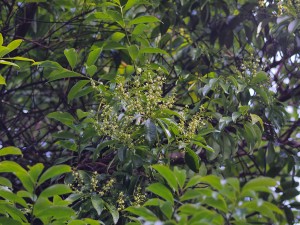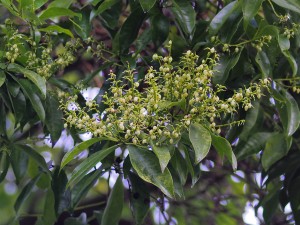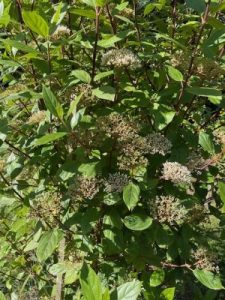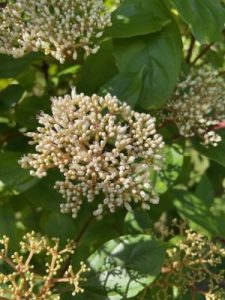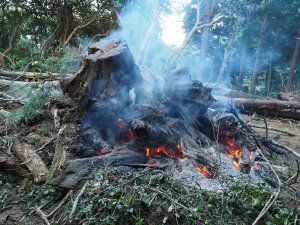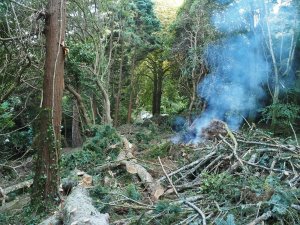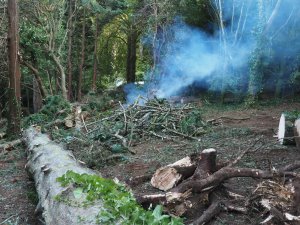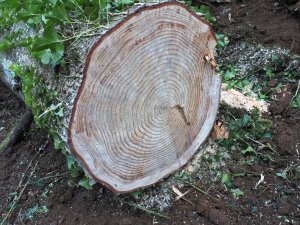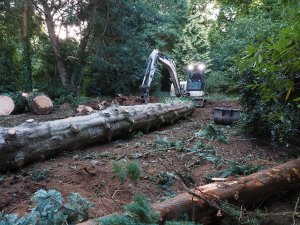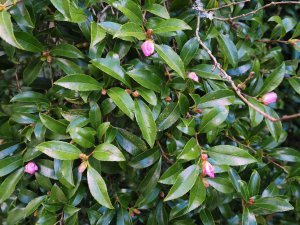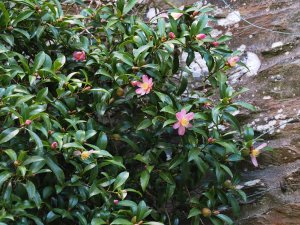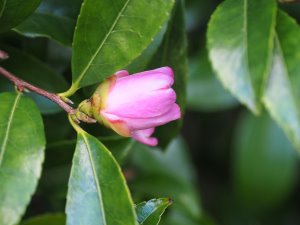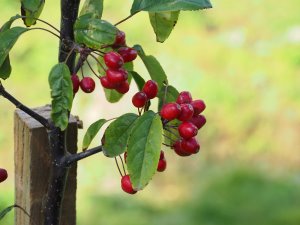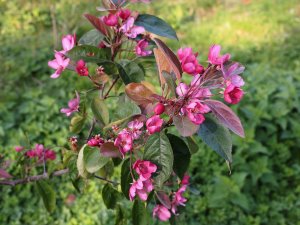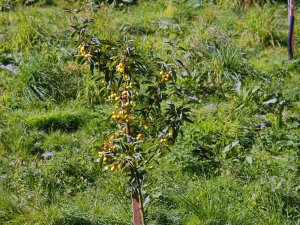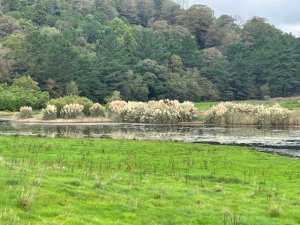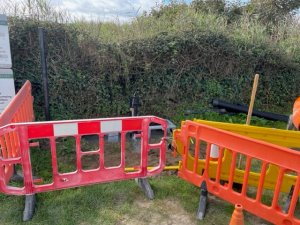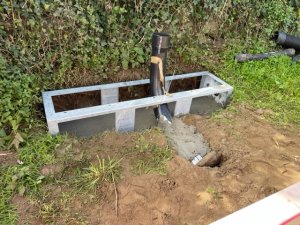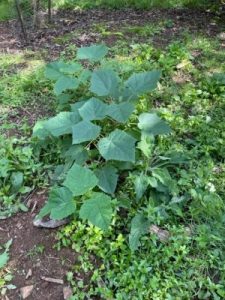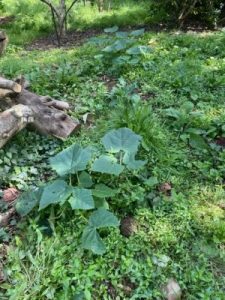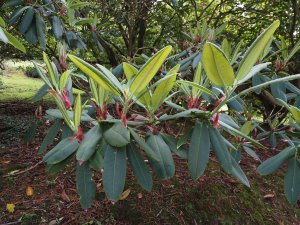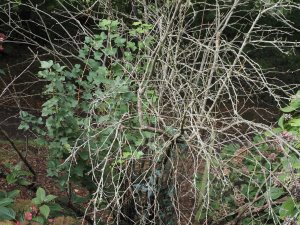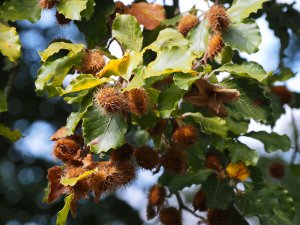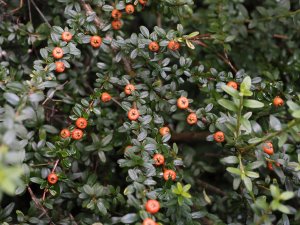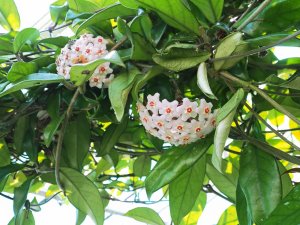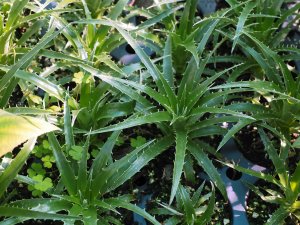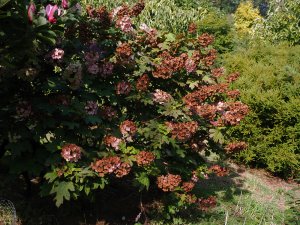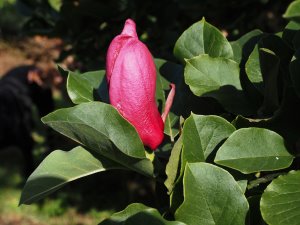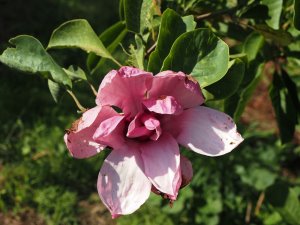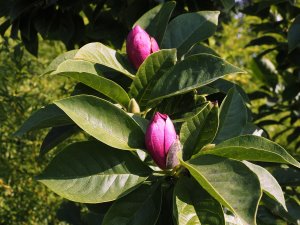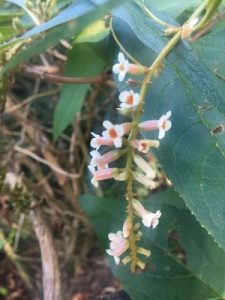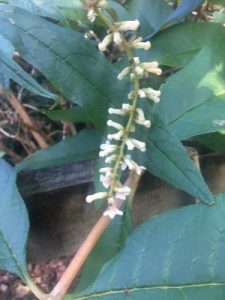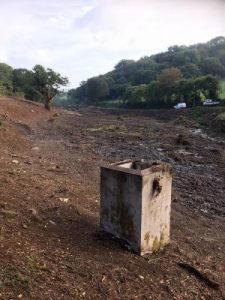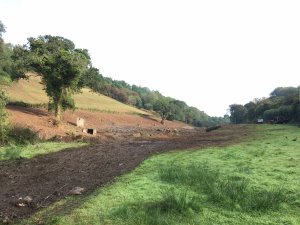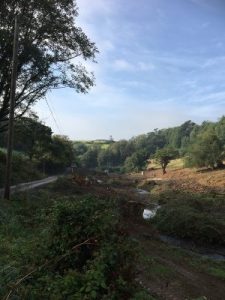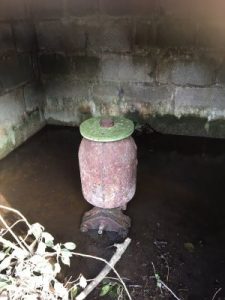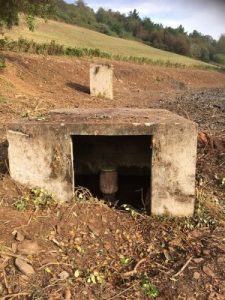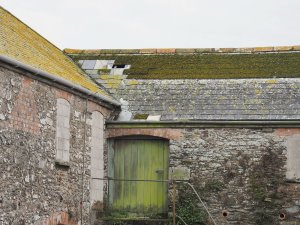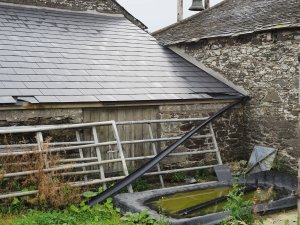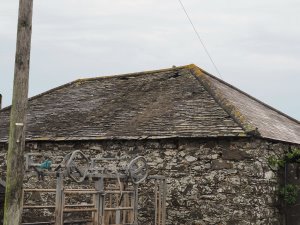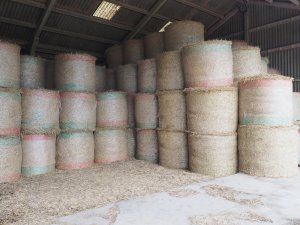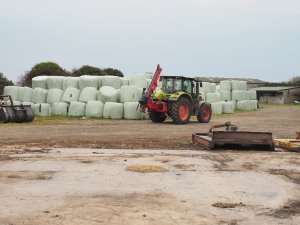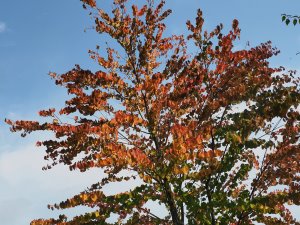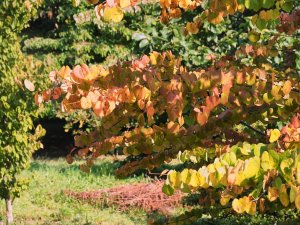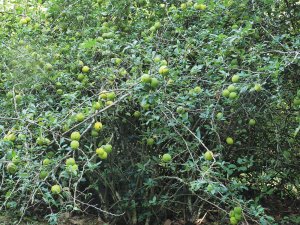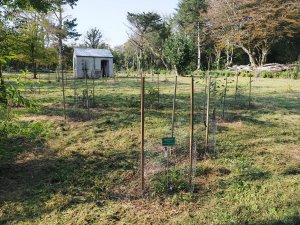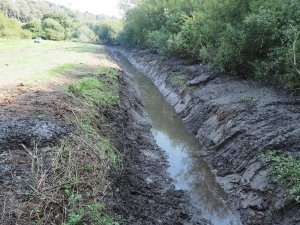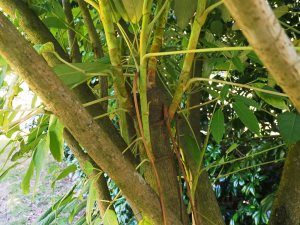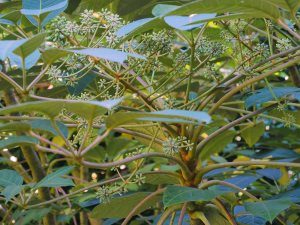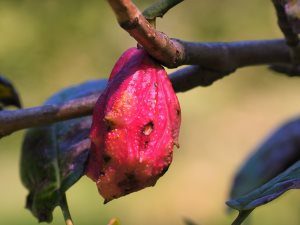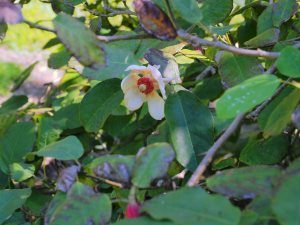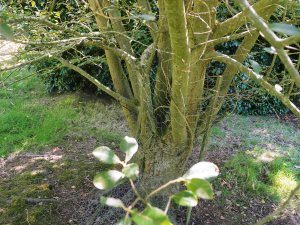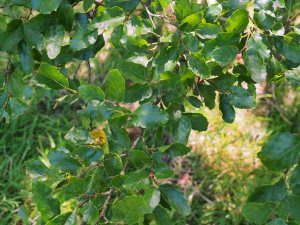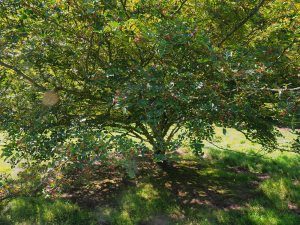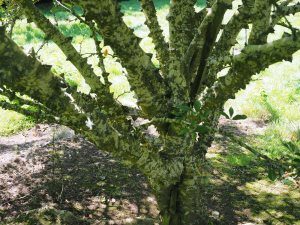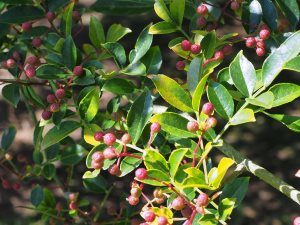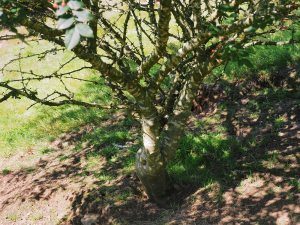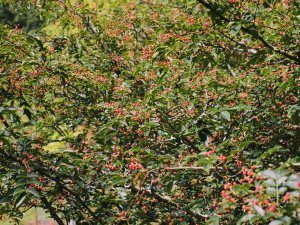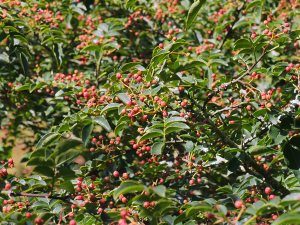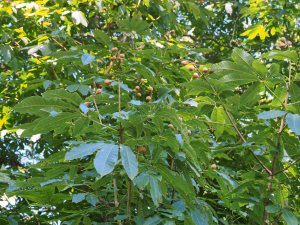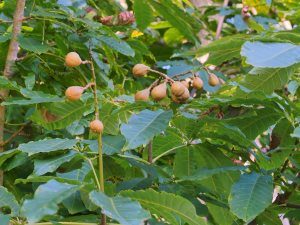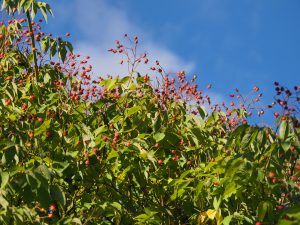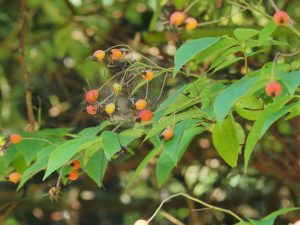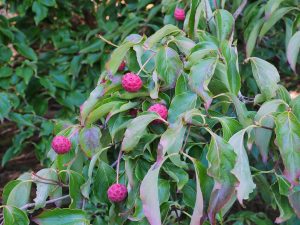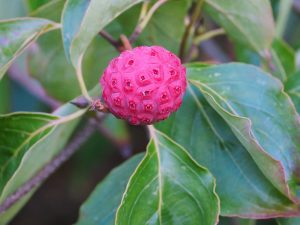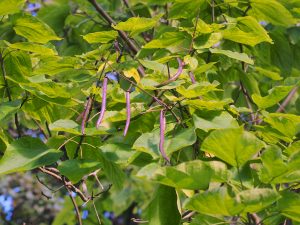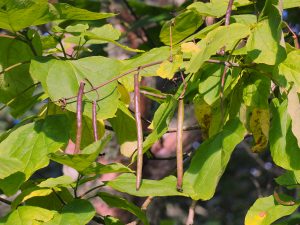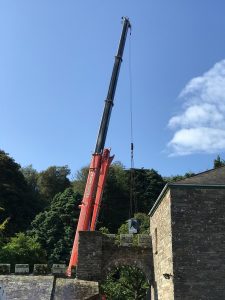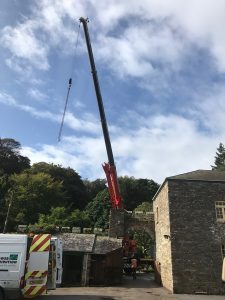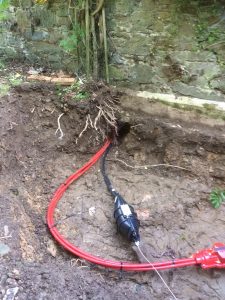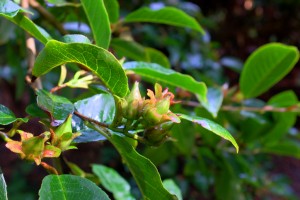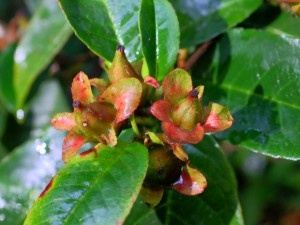2024 – CHW
Multiple seed heads colouring up on Viburnum fansipanense (BSWJ 8302).
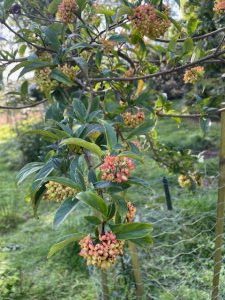
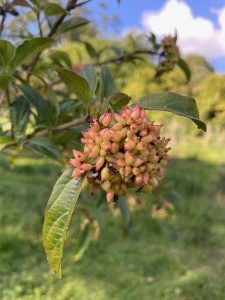
And on Viburnum coriaceum.
Ross Collins (at long last) has started work today in the Aucklandii Garden with Kel Murray now doing the tree surgery work. The primary objective is to remove a monster Turkey Oak which threatens anyone parking or standing outside the Back Yard nearest the gardens. As with many Turkey Oaks aged around 100-120 or so years, its time is up. The base has bleeding cankers and obvious Phytophthora infections, as you see in declining and decaying old trees. It has also recently developed a downward lean so it is time to act. It will leave a huge wind hole!
Today they felled a 32 year old (I counted the rings) Abies grandis which I only planted in 1992. It has grown exponentially but died, I assume, as a result of the last two dry summers. The stump still very much alive but the crown shattered as it hit the ground and was obviously dead. I planted this tree to replace a similar Abies, which grew in much the same place, was a triangulation point for the local fisherman (or so it was said). The old tree was perhaps 120 feet tall. The felled youngster perhaps 60-70? In my mind I thought I had planted the tree 10 or more years earlier after the whirlwind that destroyed all the Rhododendron aucklandii in around 1977 or 1978. Perhaps I need to go and count the tree rings again!
2023 – CHW
The first pale pink 120 year old Camellia sasanqua is suddenly just out today in the sun. A good 2-3 weeks earlier than I have ever see it out. A first in September!
Malus ‘Indian Magic’ in the Kitchen Garden with secondary flowers and fruit.
Time for a proper look at the fruiting Malus!
Pampas grass on the islands flowering away.
Electric charging points being installed at Porthluney Beach car park.
In the early spring we dug out some old camellia stumps. Where we cut into the roots of a nearby Paulownia root suckers have appeared everywhere.
2022 – CHW
Welcome rain again yesterday and remarkably good new growth on the Rhododendron ‘Harrow Hybrids’ which looked so ghastly only 3 weeks ago.
Welcome rain again yesterday and remarkably good new growth on the Rhododendron ‘Harrow Hybrids’ which looked so ghastly only 3 weeks ago.
Just a few shoots still alive after the drought on Ribes ‘White Icicle’.
Not many of our older beech trees have a proper crop of seeds like this in a drought year. The squirrels will soon find them!
Orange berries just starting to show up Cotoneaster conspicuus.
Hoya carnosa in the greenhouse.
Our seed grown Puya have moved on from being tiny seedling plugs to decent plants in less than 12 months.
No flower colouring (or leaf as yet) on this large Hydrangea quercifolia. Just dead flower panicles after the drought.
A decent secondary flower on Magnolia ‘March-til-Frost’.
And on Magnolia ‘Yakeo’.
Not quite out yet on Magnolia ‘Cleopatra’.
2021 – CHW
Buddleia forrestii in flower by the garden entrance. White buds turning pinkish when they open with pink centres to the flowers when open.
Buddleia forrestii in flower by the garden entrance. White buds turning pinkish when they open with pink centres to the flowers when open.
To give more light to the river and because the area was full of dead elm and dying ash we sought a felling licence to clear the bottom of the Portholland Valley below Parnalls Hill Wood. The licence did not arrive on time due to COVID so work only started a month ago. We have retained all the mature oak trees and some of the best mature hollies. Some of the stumps will regenerate and we will consider replanting later. Natural regeneration may be adequate.
These pictures show part of the old pumping system which pumped water up the hill to serve Caerhays and Portholland villages and neighbouring farms until the mid-1960s when mains water arrived. There were a series of lagoons in the river which fed water to gravity fed water pumps or rams. You can see some of these here but the system had three other similar ram sheds which still exist today further down the river towards Portholland. As a small child I used to go (in a Simca van) with Jim Trudgeon (farm manager) down the Portholland road where we would stop and listen to hear if the rams were all working. Often they were not and quick action was needed. This was a time of outdoor privies and few houses had bathrooms. Still fewer had washing machines. The requirement for water in households was rather less than it is today.
2020 – CHW
Some roof repairs to take care of before winter in the farmyard.
Some roof repairs to take care of before winter in the farmyard.
We are going to be short of straw this winter and will need to buy some more in after the dry weather reduced the normal crop of straw on the spring barley.
But more than enough silage.
Cercidiphyllum japonicum ‘Strawberry’ not as coloured as the one at Burncoose.
The quince is, once again, fully laden with fruits.
The third grass cut at Tin Garden so we are now ready to plant the new bulbs.
Frankie’s work on cleaning out the dykes continues.
2019 – CHW
A trip to Forty Acres Wood to see what is seeding over there.The original Schefflera macrophylla has seed heads which will not be ripe for several weeks. Last year they fell to the ground and deer ate them before we got there. Note how the large bow which we cut for Chelsea two years ago has quickly re-sprouted three large shoots.
A trip to Forty Acres Wood to see what is seeding over there.The original Schefflera macrophylla has seed heads which will not be ripe for several weeks. Last year they fell to the ground and deer ate them before we got there. Note how the large bow which we cut for Chelsea two years ago has quickly re-sprouted three large shoots.
A late flower on Magnolia sieboldii while ripe seed pods cover the rest of the bush.
This was once a Nothofagus antarctica but it has been smothered by alder growth so that the Nothofagus is just one small branch within the trunk. The Nothofagus is just the third bit in from the left. It is almost as though the Nothofagus was grafted onto an alder but more likely self-sown competing seedlings.
Zanthoxylum simulans plastered in small reddish fruits which are not yet ripe. The trunk of this small tree has enormous spines as do its branches.
Zanthoxylum piperitum has many less spines on its trunk but nasty ones on its branches. The reddish fruits were ripening and opening to reveal black seeds as you can see here. My hands smelt strongly of pepper after the seed gathering for Asia.
One of the three 50 to 60 year old Aesculus wilsonii at the entrance to Old Park has a great many smallish conkers which are still far from ripe. This is a late flowering Aesculus species so no surprise. The tree with conkers was hit by a falling branch from an oak a few years ago. This let in more light and most of the conkers are on younger regrowth.
2018 – CHW
Rather more rose hips on Roy Lancaster’s wild collected Rosa filipes than last year. They rise above the plant which is well over the top of the castle gate wall and glistening in the sunlight this evening. Well worth Asia growing a few of this vigorous but beautiful specie climbing rose.
Rather more rose hips on Roy Lancaster’s wild collected Rosa filipes than last year. They rise above the plant which is well over the top of the castle gate wall and glistening in the sunlight this evening. Well worth Asia growing a few of this vigorous but beautiful specie climbing rose.
Cornus kousa ‘Doubloon’ was covered in fruits. Since I spotted them first the pheasant poults have taken at least half of them. I have never seen the fruit on this tree before.
Catalpa bignonoides, the Indian bean tree, living up to its name. Another tree which is used to hotter temperatures and is performing well after the dry summer. While we have had some pleasant drizzle and light rain we really do need a downpour soon to get plants going again. The hydrangeas on the drive are drooping their leaves and look terrible again.
2017 – CHW
Western Power hoist in the new transformer into the back yard. No damage to the Magnolia ‘Leonard Messel’ so far.
The electrical connections to the mains under the wall look rather insignificant!
2016 – CHW
No entry.
No entry.
2015 – CHW
Another collecting evergreen cuttings day for Burncoose with six black bags to go including some particularly prickly hollies which they will not like at all.We took cuttings from Stewartia pteropetiolata which we know will root but there are plenty of good seed pods forming all of which look fertile.
Another collecting evergreen cuttings day for Burncoose with six black bags to go including some particularly prickly hollies which they will not like at all.We took cuttings from Stewartia pteropetiolata which we know will root but there are plenty of good seed pods forming all of which look fertile.
Crabiodendron yunnanense (record tree) has had only a few very late flowers some 20 feet up in the crown of the tree. We have seen this tree set seed lower down but it has proved easy from cuttings. The flowers are pieris like and normally much better than they look here.
